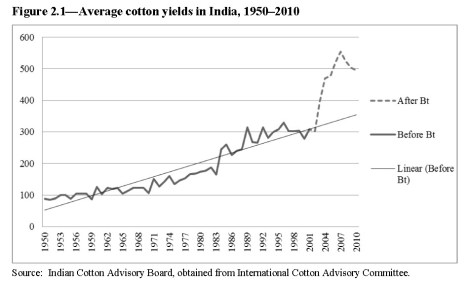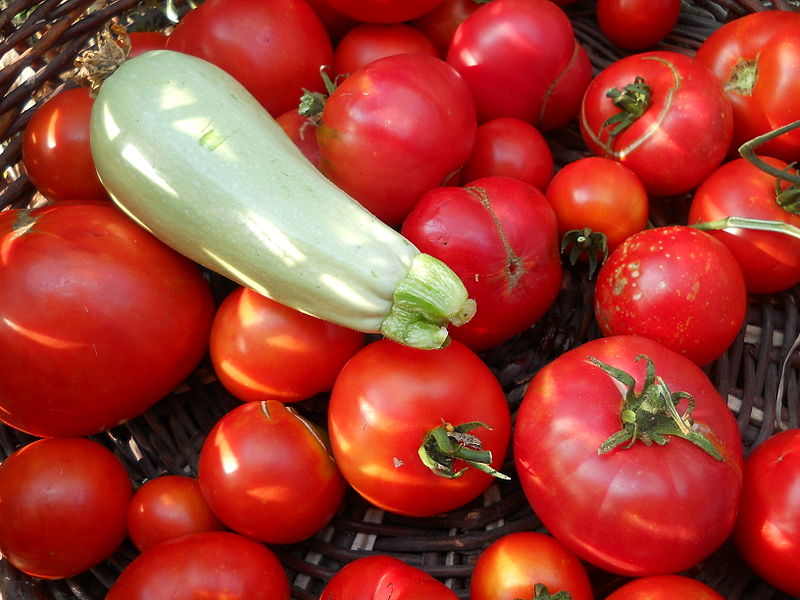Editor’s note: After we ran What I learned from six months of GMO research: None of it matters, Nathanael Johnson’s essay concluding his “Panic-Free GMOs” series, we heard from a lot of people who think that GMOs really do matter. We’re publishing three two responses: one from Tom Philpott, whose work long graced these pages and who is now at Mother Jones; and, today, one from Ramez Naam, author of The Infinite Resource: The Power of Ideas on a Finite Planet. (We’d planned to run another response from Denise Caruso, author of Intervention: Confronting the Real Risks of Genetic Engineering and Life on a Biotech Planet but that piece did not materialize.)
The folks at Grist have kindly allowed me to pen a guest post here with a few thoughts on Nathanael Johnson’s excellent series on genetically modified foods and in particular his most recent piece on what he learned from 6 months investigating the GMO debate: that none of it really matters.
This most recent piece nails several key points that often go completely missed. When we get down to the specifics, we find that today’s GMOs are neither planetary panacea nor unbridled poison. The passionate, emotion-filled debate is more about the lenses through which we see the world as it is about genetically modified foods themselves. The GMO debate is often an emphatic and barely-disguised metaphor for our larger debate about whether technology is destroying the world or saving it, whether we should try to control nature or live within it.
That’s not to say the debate, when it touches on GMOs themselves, is balanced. The scientific consensus is that GMOs are as safe to eat as any other food, that they reduce soil-damaging tillage, reduce carbon emissions, reduce insecticide use, and reduce the use of the most toxic herbicides in favor of far milder ones. GMOs have limitations, and some of their benefits are threatened by the rise of pesticide resistance. Even so, on balance, GMOs are safe and produce real benefits. As I wrote at Discover Magazine last year, GMOs achieve many of the goals of organic agriculture. (To balance that out, let me state that I also wrote there that GMO supporters should embrace sensible GMO labeling.)
But Johnson is also right that, in the U.S., the stakes are not at present world-changing. U.S. farmers could likely get by without GMOs. We might see upticks in toxic pesticide use and river runoffs, in soil-harming tillage, and in carbon emissions, but none of those would prove catastrophic. There might be a very slight reduction in crop yield, but not by much, and not for long. The vast majority of us would never notice.
In that context, I agree that the current debate is more about abstractions, metaphors, and worldviews than it is about the realities on the ground.
Even so, I think there are two important reasons we should care about GMOs, and view them, certainly not as panaceas, but as imperfect but important tools that can improve the lives of millions of people right now and possibly have an impact on billions of lives and millions of square miles of nature in the decades to come.
Why We Should Care — The Long Term
The Food and Agriculture Organization of the UN estimates that we need to grow 70 percent more food by 2050. Either we do this on the same land we have today, or we chop down forest to create farms and pastures to meet that demand, something no one wants to do.
Jon Foley at the Institute on the Environment points out, quite rightly, that it’s meat consumption, not population, that’s driving global food demand. So we could, instead, reduce meat consumption. That’s a noble goal. Unfortunately, meat consumption has roughly quadrupled in the last 50 years, primarily driven by increasing wealth in the developing world, with no sign of stopping. I welcome any practical plan to reduce meat consumption worldwide, but until then, we have to find a way to keep boosting food production.
Another way to feed the world is to close the “yield gap” between farms in the rich and poor worlds. Farmers in the U.S. grow twice as much food per acre as the world overall, largely because they can afford farm equipment, fuel, fertilizer, and pesticides that many farmers in the developing world can’t. Some of this gap, undoubtedly, will be closed as poverty drops around the world. But it’s unrealistic to assume that all of it will.
What are we to do? On the horizon are some GMOs in development that could provide a dramatic boost here.
- Better photosynthesis. Corn and sugarcane grow nearly twice as much food per acre as the crops humans eat most: rice and wheat. Why? Corn and sugarcane have a better way of doing photosynthesis — of turning light, plus water, plus CO2 into carbohydrates. This newer system is called C4 photosynthesis. Researchers around the world — funded by nonprofits like the Gates Foundation — are working on creating C4 Rice and C4 Wheat. Those crops could grow 50 percent more food per acre.
- Self-fertilizing crops. Fertilizer boosts plant growth by adding nitrogen, and access to fertilizer is one reason rich nation farms grow so much more food per acre than their developing world counterparts. But fertilizer runoff is also responsible for the Gulf dead zone and similar zones around the world. Some crops, though, can fertilize themselves by pulling nitrogen from the air. Legumes, like soy, peas, and clover do this. Another nonprofit funded GMO research area is to transfer this ability to cereal crops, creating self-fertilizing wheat, corn, and rice. That would have two advantages: It would boost yields for poor farmers who can’t afford additional fertilizer; and it would cut down on nitrogen runoff that creates these ocean dead zones.
These are just two projects among many, along with creating more drought-resistant crops, more salt-resistant crops, and crops that have higher levels of vitamins and minerals that people need.
Now, let me be very clear. Most of these are research projects. They’re not in the here and now. They’re not going to arrive this year, and probably not in the next 10 years. And we do continue to make great progress in improving crops through conventional breeding. But we’re unlikely to ever get to, say, C4 rice or C4 wheat through conventional breeding.
The bigger point here isn’t that we absolutely need GMOs to feed the future world. If we banned all future GMO development and planting, we’d most likely muddle through in some way. Humanity is good at innovating, particularly when our back is to the wall. But we’d be fighting this battle to keep increasing food output with one arm tied behind our back. We might make less progress in boosting yields, without GMOs, meaning food prices would be higher, hunger would be higher, or we’d have more pressure to chop down forests to grow food.
Or maybe we’d be just fine. But given the size of the challenge, and the absence of any credible evidence of harm from GMOs, robbing ourselves of this part of our toolkit strikes me as foolish.
Why We Should Care — The Here and Now
The future’s easy to discount. So let’s come back to the present, and in particular, the present reality for the 6 billion people who live outside of the rich world.
Until recently, the majority of the acres of GM farmland in the world have been in rich nations. Today, the U.S. ranks first, followed by Brazil and Argentina (what we’d call middle income nations), and then Canada (another rich nation). That means that when we look at how GM crops perform, we tend to focus on how they do in countries where farmers have access to farm equipment, fertilizer, pesticides, irrigation, and so on. And in those countries we see a real but modest benefit.
In the developing world, it’s markedly different.
India allows only one genetically modified crop: GM cotton with the Bt trait, which makes the cotton naturally resistant to insects and reduces the need to spray insecticides. In the U.S., there’s a broad consensus that Bt corn has reduced insecticide spraying (which is good) but less evidence that it’s increased how much food is actually produced per acre, at least to a significant degree. In India, where quite a large number of farmers can’t readily afford pesticides, and where they lack farm equipment, meaning that pesticides must be applied by hand, the situation is dramatically different.
For the decade between 1991 and 2001, cotton yields in India were flat, at around 300 kilograms per hectare (a hectare is about 2.5 acres). In 2002, Bt cotton was introduced into the country. Farmers adopted it quickly, and yields of cotton soared by two thirds in just a few years to more than 500 kilograms per hectare.
Between 1975 and 2009, researchers found that Bt cotton produced 19 percent of India’s yield growth, despite the fact that it was only on the market for 8 of those 24 years. The simpler view is that Bt cotton, in India, lifts yields by somewhere between 50 percent and 70 percent. You can see for yourself in the graph below.

Why does this matter? There are 7 million cotton farmers in India. Several peer reviewed studies have found that, because Bt cotton increases the amount of crop they have to sell, it raises their farm profits by as much as 50 percent, helps lift them out of poverty and reduces their risk of falling into hunger. By reducing the amount of insecticide used (which, in India, is mostly sprayed by hand) Bt cotton has also massively reduced insecticide poisoning to farm workers there — to the tune of 2.4 million cases per year.
You may perhaps be wondering: Don’t GMOs lead to more farmer suicides in India? And while farmer suicides in India are real, and each one is a tragedy, the link is false. Farmer suicides have been going on long before GMOs, and, if anything, the farmer suicide rate has slightly dropped since the introduction of GM seeds.
In China we’ve seen similar impacts of Bt cotton, with multiple studies showing that Bt cotton increased yields, boosted the incomes of 4 million smallholder farmers, and reduced pesticide poisoning among them.
All of this is to say that GM crops have more impact in poor countries than rich ones. Where other types of inputs, like fertilizers, farm equipment, and pesticides are harder to afford, GM crops have more to offer. That can help increase food, reduce pressure on deforestation, and lift farmers out of poverty.
But the world’s poorest countries, and in particular India and the bulk of sub-Saharan Africa, don’t allow any GM food crops to be grown. India came close to approval for a Bt eggplant (or Bt brinjal). Studies showed that it was safe, that it could cut pesticide use by half, and that it could nearly double yields by reducing losses to insects. But, while India’s regulators approved the planting and sale, activists cried out, prompting the government to place an indefinite moratorium on it. Similar things have happened elsewhere. The same Bt eggplant was supported by regulators in the Philippines who looked at the data, but then blocked by the court on grounds that reflected not specific concerns, but general, metaphorical, and emotional arguments that Nathanael Johnson describes as dominating the debate.
That’s a pity. Because if Bt food crops could produce similar size gains in the developing world, that would be a tremendous benefit. Insect losses are a tremendously larger challenge in India and Africa than in the U.S. Boosting the amount of food that a farm produces by half or more means less hunger, more income for farmers (still the majority of the population in the world’s poorest countries), and more ability of people to pull themselves out of poverty.
The same arguments that kept Bt eggplant out of the Philippines have also been used, often by western groups, to keep GM crops out of virtually all of Africa, as documented by Robert Paarlberg in his powerful (and to some, infuriating) book Starved For Science.
I have absolutely no doubt that the opponents of genetically modified foods, and particularly those campaigning against their planting in the developing world, are doing this with the best of intentions. They fully believe that they’re protecting people in Africa, India, the Philippines, and elsewhere against poisons, against corporate control of their food, or against destruction of their environment. Yet I wish more of them would read Nathanael Johnson’s carefully thought-out series here and in particular his argument that most of the debate is highly inflamed.
Most of the perceived ills of genetically modified foods are either illusory or far smaller than believed. And what the data suggests is that the benefits, while modest in the rich world today, might be quite substantial in the future, and are already much larger in the parts of the world where the battle over GMO approval is most actively raging.
GMOs are neither poison nor panacea. What they are is a toolkit, a varied one, with real benefits to the environment and millions of people today; with the real potential to have a larger positive impact immediately if they’re allowed to; and with the possibility of a dramatically larger benefit down the road as the science behind them improves.



